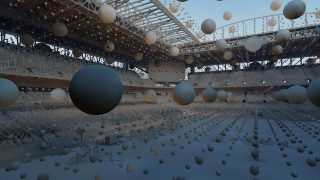EA Presents on Content Creation, Real-Time Rendering, and More at SIGGRAPH 2024
Contributors from SEED, Frostbite™, and EA SPORTS™ share exciting advancements at this year’s conference.
July 29, 2024

Talented individuals from across Electronic Arts present at this year’s Special Interest Group on Computer Graphics and Interactive Techniques (SIGGRAPH) conference. Talks and courses with EA contributors include the following highlights:
- Strategies employed by art, technical art, and render teams to tackle the scale of building EA SPORTS™ College Football 25.
- Two talks in the Advances in Real-Time Rendering course:
- Flexible and Extensible Shader Authoring in Frostbite with Serac
- An update on the Global Illumination Based on Surfels (GIBS) lighting system
- A Position Based Material Point Method that could allow for the integrated simulation of new physical material types and a higher fidelity simulation of object destruction.
- An Educator’s Day Session on our work with academic partnerships to drive innovation at the intersection of academia and industry.
SIGGRAPH 2024 looks ahead to the next half-century of computer graphics and interactive techniques distinction following their 50-year history. Get a glimpse into EA contributions at this year's conference.
EA SPORTS College Football Is Huge: Delivering a Triple-A Sports Game at Scale
Contributors: Ishaan Singh, Jay Goodman, and Richard Burgess-Dawson (EA SPORTS)
When: Sunday, July 28, 2024 (9:00am - 9:45am MDT)
Lighters, world artists, technical artists, and render engineers successfully tackled an enormous production developing EA SPORTS College Football 25. The adoption of existing EA technologies, along with the creation of new techniques, allowed for collaboration between teams that played a crucial part in the construction of a massive game.

The game’s scale required a re-imagining of content creation and rendering methods. Unique strategies discussed in this presentation included:
- The Stadium Toolkit designed to help construct 150 stadiums at a rapid pace
- The adoption and customization of the GIBS lighting system used for stunning illumination
- Machine learning clustering techniques to find the closest head representations of over 11,000 athletes
- Systems using a curated library of known-good parts to craft uniforms in real time within the game engine
This presentation provided insight into one of the most ambitious EA SPORTS productions yet, featuring methods, technologies, and visual experiences working at unprecedented scale.
Advances in Real-Time Rendering in Games
Contributors: Simon Taylor and Diede Apers (Frostbite)
When: Tuesday, July 30, 2024 (Part I 9:00am - 12:15pm, Part II 2:00pm - 5:15pm MDT)
Frostbite will have a strong presence throughout the two-part course on Advances in Real-Time Rendering in Games. This course focuses on state-of-the-art rendering techniques for fast and interactive rendering of complex and engaging virtual worlds.
This well-established SIGGRAPH series continues in 2024 with contributions from Frostbite engineers, along with other speakers from Activision, Intel, and Tencent Games.
Part I (Includes Simon Taylor, Senior Software Engineer, Frostbite)
Large game engines have complex features and systems, as well as mechanisms to customize and extend those systems. This poses a particular problem for shader code since modern shading languages prioritize performance over flexibility and extensibility.
Serac is a domain-specific language “wrapper” around High-Level Shader Language (HLSL) built to address this problem without sacrificing performance. This presentation will include an overview of what Serac is, how it fits into the broader shader authoring workflows in Frostbite, and what differentiates it from other similar approaches.
Part II (Includes Diede Apers, Software Engineer, Frostbite)
Developers from SEED and Frostbite first introduced the GIBS lighting system at SIGGRAPH 2021. GIBS produces dynamic diffuse global illumination, and this year’s conference will follow up with an update on how GIBS has progressed during the Advances in Real-Time Rendering in Games courses.

GIBS recently shipped with EA SPORTS College Football 25 and is being used in an upcoming open-world action game. This talk will cover both games’ requirements and budgets imposed on GIBS, and discuss several practical learnings, improvements, and optimizations that were crucial to achieving truly dynamic global illumination at 60fps on current-generation consoles.
A Position Based Material Point Method
Contributors: Christopher Lewin (SEED)
When: Thursday, August 1, 2024 (2:44pm - 3:06pm MDT)
The Material Point Method (MPM) can be used to simulate a variety of complex materials, including viscous liquids, sands, soils and plastics. However, the standard MPM methods are too unstable to be used in games.
The Position Based Material Point Method (PB-MPM) implemented by SEED is much more stable than explicit MPM and could allow the integrated simulation of these new physical material types in games, by allowing for much larger time-steps than standard MPM simulations.
This presentation will explain both standard MPM and our new variant of it in straightforward terms, allowing any game developer to include deformable material simulation in their game if they wish.
Other Events Sponsored by EA at SIGGRAPH 2024
Contributors: Colin Barré-Brisebois (Head of Technology, SEED), Konrad Tollmar (Head of Research, SEED)
When: Tuesday, July 30, 2024 (2:00pm - 3:30pm MDT)
EA is a proud Champion sponsor at SIGGRAPH 2024 and is committed to driving and supporting the SIGGRAPH community.
During the Educator's Day Session panel, we will discuss our ecosystems of academia and institutional partners for inspiration and synergy. This session will focus on our efforts to push cutting-edge research, build early-career talent, and drive the future of interactive entertainment.
At SIGGRAPH 2024, we are also lifting the emergence of AI and CG in video games. This research area depends significantly on the availability of high-quality datasets.
Collaboration between academia and industry to develop and share these high-quality datasets is essential for advancing AI research and creating richer experiences.
For further reading on this SIGGRAPH topic, check out Konrad Tollmar’s article, Propel Academic and Industrial Research With Open Datasets, on the official ACM SIGGRAPH blog.

